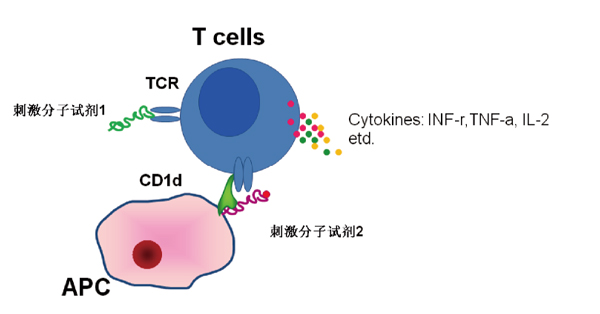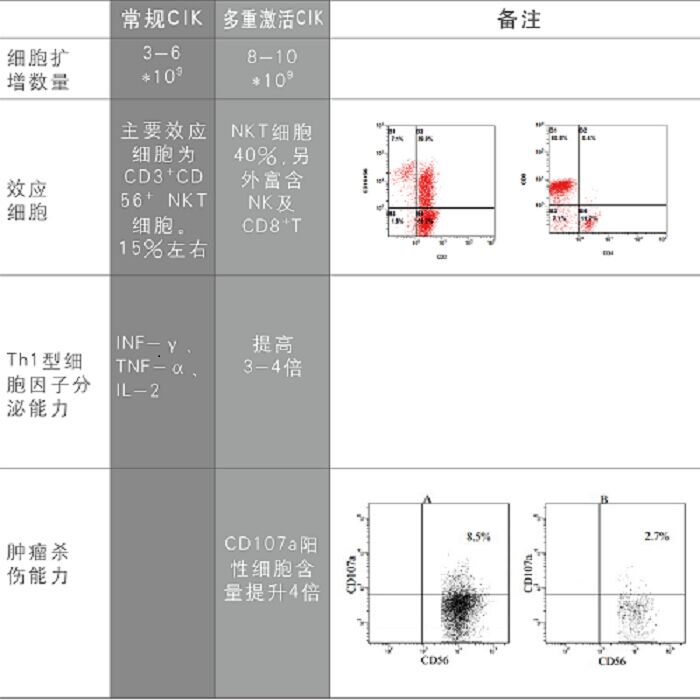Multiple activated cytokine induced killer cell
Technical introduction
Multiple activated CIK (Multipleactivated cytokine induced killer cell)
It is a group of effector cell populations rich in NKT, NK and CD8+T.
This technology uses blood lymphocytes, stimulated by multiple activation of different proteins and glycolipid molecules, and expanded in vitro to obtain a large number of tumor-killing effector cell populations. After reinfusion, it can directly kill tumor cells in vivo and promote T cells and DC cells in the body mature, increase the Thi type in serum, secrete a large number of cytokines (IL 2, TNF-a and IF N-y), and synergistically kill tumors.
This therapy is suitable for early, middle and late stage tumor patients. After clinical observation, it has achieved good clinical results in lung cancer, dietary cancer, gastric cancer, intestinal cancer, brain tumor, breast cancer, ovarian cancer, prostate cancer and other tumors. curative effect. Combined with traditional therapies such as surgery, radiotherapy, and chemotherapy, it can prolong the survival period of cancer patients and improve the quality of life of patients.
Technical principle

The blood is separated to obtain foreign blood lymphocytes, which contain T, lymphocytes, DC cells, and monocytes. The first signal of T cell activation comes from the receptor on the surface of T cells, namely T cell antigen receptor (TCR), which combines with specific proteins and glycolipid molecules through APC antigen presenting cells to form complexes. This leads to a cascade of kinase activation (phosphatidylinositol pathway or MAP kinase pathway, etc.), and finally activates transcription factors to enter the nucleus and bind to target genes (such as IL-2 and IL-2) that regulate T cell proliferation and activation. IFN-g, etc.), causing gene expression and transcription, T cells are thus transformed from a quiescent state to a proliferating and activated state, resulting in a large number of Mact-CIK cells.
Technical advantages (vs conventional CIK)

Advantages of multiple activated CIK cells in anti-tumor immunotherapy
1. Mact-CIK cells proliferate rapidly and can be expanded in a large amount in a short period to meet the needs of clinical treatment;
2. Mact-CIK cells have a specific mechanism to recognize tumor cells, and have no toxic side effects on normal cells;
3. Mact-CIK cells have high tumoricidal activity, broad tumor killing spectrum, and are equally sensitive to multiple drug-resistant tumor cells;
4. The tumoricidal activity of Mact-CIK cells is not affected by immunosuppressive agents such as CsA (cyclosporine A) and FK506 (Pulecofu);
5. Mact-CIK cells are activated autologous cells, with good safety, no rejection and other reactions, and less side effects.
Multiple activated CIK cells for tumor types
Various sarcomas, melanoma, kidney cancer, non-Hodgkin's lymphoma and well-differentiated adenocarcinoma, liver cancer, lung cancer, breast cancer, rich neck cancer, ovarian cancer, digestive tract tumors (such as gastric cancer, colon cancer, esophageal cancer) , pancreatic cancer, laryngeal cancer, head and neck tumors, lymphoma (except T-cell lymphoma), leukemia, multiple myeloma, etc.
Multiplex activated CIK cell therapy for tumor timing
Mact-CIK cell therapy can be used for tumor patients of any stage, and early, middle and advanced cases have good short-term curative effect. Patients with surgical resection, intervention, radiofrequency, hydrogen-ammonia knife and other treatments at the same time or after treatment have better curative effect. SCIK cells can kill and remove extremely small tumor foci that cannot be surgically removed or scattered tumor cells in the body, and play a role in delaying or preventing tumor metastasis or recurrence. Some patients who are temporarily unwell for surgery, intervention or other treatments can also undergo immune cell therapy first to improve their physical function, improve their quality of life, and strive for other treatment opportunities.